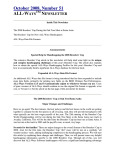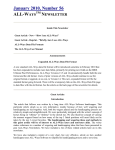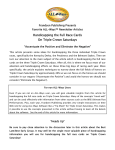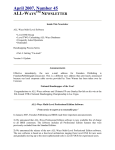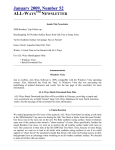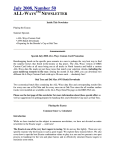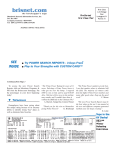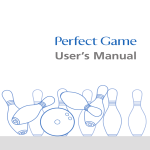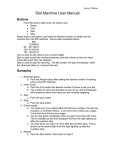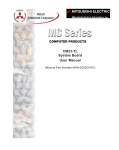Download Final Handicapping Process Series Part 1
Transcript
Frandsen Publishing Presents Favorite ALL-WaysTM Newsletter Articles Handicapping Process Series Part 1 of 6: Toolbox vs. Black Box Handicapping Plus Isolating the Contenders and the Most Likely Horses to Win A critical element of striving for profitable play is the absolute need to develop a personal, organized, and efficient handicapping process that neatly coordinates with the wagering decisions that must be made. This is the first in a series of six articles, including a “wrap-up” article, that covers how to develop an effective handicapping process in a simple, logical, step-by-step manner. This Part 1 of the series discusses the important differences in “Toolbox” handicapping versus “Black Box” handicapping. It also covers important early handicapping tasks of identifying all the horses having a legitimate chance to finish in the top 4 positions and the 3 or 4 horses with the best chance of winning the race. Some Background Previously, as part of the Favorite ALL-Ways Newsletter Articles series, Frandsen Publishing published a five part Wagering Series that focused on how best to integrate handicapping and wagering decisions to reach and sustain profitable play. A critical element of striving for profitable play is the absolute need to develop a personal, organized, and efficient handicapping process. If you have not read the articles in the Wagering Series, we suggest you at the least read the series wrap up in Part 5. It is a good summary of how to reach profitable play and it includes a powerful one-page Reference Sheet that you can take to the track. All past ALL-Ways Newsletters, as well as a Major Topic Index, are posted on both the BRIS and Frandsen Publishing Web sites and they are always free. Also, articles already published as part of the Favorite ALL-Ways Newsletter Article series are posted in the Newsletter Section on the Frandsen Publishing Web site and they are free as well. See the links at the end of this article. For Non-ALL-Ways Users Even if you do not currently use ALL-Ways software, you will still gain helpful insights from this Handicapping Process Series. A number of ALL-Ways handicapping factors are used in this article to illustrate the handicapping process concepts that are discussed. These concepts “travel well” and can be used effectively with handicapping information from other sources, such as the BRIS Ultimate Past Performances. If you do want to try ALL-Ways software as you follow this Handicapping Process Series of articles, please see the box near the end of this article for how to do so. Handicapping Process Series Introduction The goal of this five-part series is to help develop a personal handicapping process that efficiently takes advantage of advanced handicapping information. Important Reminder Your primary handicapping job is to identify, in advance, the two out of three races that are not won by the crowd favorite and to identify the two non-favorite horses most likely to beat the favorite. Here are the six sequential steps that are part of an effective handicapping process: Step 1: From the full field of horses, isolate all horses having a legitimate chance to finish in the top 4. (Include the favorite.) Step 2: Isolate the top 3 or 4 candidates to win the race. (Include the favorite.) Step 3: Classify the favorite as legitimate, vulnerable or false. Step 4: Identify the two non-favorite horses most likely to beat the favorite. Step 5: Identify a non-favorite Key-Horse. Step 6: Make final handicapping decisions. Here is what is planned for this five part Handicapping Process Series: Part 1: This introduces the concept of Toolbox Handicapping and covers Step 1 (Isolate all horses having a legitimate chance to finish in the top four finish positions) and Step 2 (Isolate the top 3 or four horses most likely to win the race.). This will provide a good starting point for developing your handicapping process. Part 2: The process discussed in Part 1 for isolating the top 3 or 4 horses most likely to win the race is the Keystone of all our handicapping efforts. So, Part 2 focuses more on this subject and also completes Step 3 (classifying the favorite as legitimate, vulnerable or false). It is titled “The Keystone of the Process”. Part 3: This part covers the remaining handicapping steps, which are Step 4 (Identify the two horses most likely to beat the favorite), Step 5 (Identify a good Key-Horse), and Step 6 (Making final handicapping decisions). It is titled “Key Decisions”. Part 4: It is easy to make the effort of developing a personal handicapping process harder than it needs to be. Part 4 of the series provides ideas that are helpful for making good progress with less hassle. It is titled “Getting Unstuck”. Part 5: Along the way, it is helpful to objectively evaluate how well the developing handicapping process is working and to identify ways to improve the process. This is the subject of Part 5 of the Handicapping Process Series. It is titled “Feedback”. Part 6: This part not only wraps up the Handicapping Process Series, but also ties the handicapping process back to the comprehensive five-part Wagering Series previously published by Frandsen Publishing. The “wrap-up” article includes a powerful one-page Handicapping Process Reference Sheet that you can take to the track. The “Wrap-Up” Reference Sheet has been added at the end of this Part 1 article so, as you progress through the full series, you can see how the individual steps evolve into the overall handicapping process. That is probably enough of an introduction. Let’s get started with Part 1. “Toolbox” vs. “Black Box” Handicapping “Toolbox” handicapping is good. “Black Box” handicapping does not work. Let’s explore this a bit. Beginning in the 1990’s and continuing to this day, a number of handicapping software programs have been introduced in the market. Some of these were considered to be “black box” software programs. This means that everyone using the program obtained exactly the same handicapping results. In other words, you and everybody else using the software were expected to play the horses selected by the software without any personal interaction in the handicapping process. It is like saying “Don’t confuse me with the facts. Just show me which horses to bet.” Here is why this approach does not work. If the “black box” software selections are good and the results profitable, word would spread like a wild fire and handicapping professionals and syndicates all over the world would begin using the software. The result would be greatly reduced payoffs with profits turning to losses. Such is the nature of parimutuel wagering. In pari-mutuel wagering, you are not playing against the house (like playing slot machines in a casino). Instead, you are playing against all the other handicappers playing the same races (like playing poker). This is a very important distinction because it means, if you do a better job of handicapping than the other players, you can make a profit at their expense. You are not playing for the tracks money. You are playing for the money bet by other handicappers who are your competitors. And, these competitors may be sitting across the room from you, or in another room at the same facility, or at a simulcast facility across the country or, nowadays, at his or her computer at home taking advantage of on-line account wagering. ALL-Ways software was designed with all this in mind. We wanted ALL-Ways software to be a toolbox full of effective handicapping tools. We wanted ALL-Ways software users to be able to select the ALL-Ways software tools that best fit their interests and style of play and integrate the selected tools into their personal handicapping process. ALL-Ways handicappers doing the best job of selecting and integrating the tools would achieve the best handicapping results. ALL-Ways software is not the only “toolbox” out there. All the handicapping products available from BRIS can certainly be considered as a giant box of effective handicapping tools. Nobody uses every one of BRIS products and no one uses every one of ALL-Ways software tools either. You select the tools that work best for you. Here is some strong advice we would like to impart as we begin this Handicapping Process Series: ∙ Do not shy away from advanced handicapping information. It is this advanced information that will give you an edge. If you do shy away, you will be left behind because the best of your competitors will be using it. ∙ Strive to obtain as much unique information as possible. It is not how much information that is important. It is how unique the information is and how well you integrate it into your personal handicapping process. BRIS users have an advantage over non-BRIS users. ALL-Ways software users have a distinct advantage over nonALL-Ways software users. With that said, let’s start developing a handicapping process. We start by quickly reviewing some of the fundamental elements of ALL-Ways software. ALL-Ways Fundamentals ALL-Ways software automatically creates handicapping profiles made up of the best combination of handicapping factors for each specific type of race at each specific track you play. ALL-Ways software uses the appropriate handicapping profile to handicap each specific race. We recommend new ALL-Ways software users download and use the free track specific handicapping profiles from the Frandsen Publishing Web site until they have built up 200 to 300 or so races in their ALL-Ways Race Database for the track(s) they play. When you have 200 to 300 races, you can let ALL-Ways software take over and automatically create and maintain (update) the profiles in your computer. Using these Handicapping Profiles, ALL-Ways software generates a win percent probability for each horse and a corresponding odds-line for the race. ALL-Ways software then identifies the horses it believes to be the primary contenders in the race. Then ALL-Ways software looks at the remaining horses to see if there is a reason to look further at any of these “non-contenders”. If it finds such a reason, ALL-Ways software designates the horse as a Dangerous Non-Contender (DNC). ALL-Ways software users can set a Preference item that instructs ALL-Ways software to use “normal” or “tight” criteria for designating Contenders and DNC's. A “tight” setting results in fewer horses being designated than a “normal” setting. We recommend new ALL-Ways software users start with the “tight” setting. Developing Your Personal Handicapping Process We are about to explore a process that works well for this author/handicapper. We are not proposing this as a universal process that will work for everyone. However, discussing this process will give you some ideas for developing your own personal handicapping process. We reference a number of different ALL-Ways software handicapping factors and a number of ALL-Ways software handicapping reports. These factors and reports are explained in Appendix B and Appendix C respectively in the ALL-Ways User Manual. Note: If you prefer to learn only one handicapping report in ALL-Ways, the Spot Play/Final Process Handicapping Report can be used as an excellent “stand-alone” handicapping report. Step 1: Isolate all legitimate candidates having a chance to finish in the top 4. This must include the favorite. This is perhaps the area where ALL-Ways software saves the most time. Here is the process we use to carry out Step 1: a) We start with the ALL-Ways Contender Summary Report. This report shows only the horses designated by ALL-Ways software as contenders. It displays and compares these horses side-by-side. b) Then we add any horse, not already selected, that ranks in the top 3 of the BRIS Late 2/3 factor as shown on a number of different ALL-Ways handicapping reports including the Search Handicapping Report. The Late factor is the sum of BRIS Final Fraction + BRIS Speed. The 2/3 notation indicates the figure is the average of the horse’s best 2 out of its last 3 races for the factor. Horses with good BRIS Late ratings have a good combination of speed and closing ability down the stretch. We have found that these BRIS Best Late 2/3 horses account for many surprise top 4 finishers. c) Then we add any horse, not already selected, with a recent (within last 120 days) Top 10 BRIS Speed performance as shown on the Top 10/Ranking Handicapping Report. d) Then we add any horse, not already selected, that is designated by ALL-Ways software as a Dangerous Non-Contender. This Step 1 only takes a minute or two. In most cases, only one or two horses are added to the contenders as a result of steps b, c and d above. Sometimes there are no additions to the list of contenders. Sometimes, in very, very contentious races, 3 or 4 horses may be added. Overall, we are generally working with 4 to 6 horses in 8 to 10 horse fields and 6 to 8 horses in 12 horse fields. Keep in mind that this first step simply gets rid of horses we believe have no chance of finishing in the top 4 finish positions. Step 2: Isolate the top 3 or 4 candidates to win the race. This also must include the favorite. At this point, in Step 1 we isolated all the horses we feel have a chance to finish in the top 4 finish positions. As we now explain Step 2, we will see that it not only achieves the goal of the step, which is to narrow down the choices to just those horses we believe have a chance to win the race, but that it also sets us up to make effective decisions in Steps 3 through 6, which we will cover in Part 2 and Part 3 of this Handicapping Process Series. What we do is to classify each of the top 4 finish position candidates from Step 1 into one of three groups: Group 1: Includes all the candidates we believe have a chance to win the race. Group 2: Includes all the other candidates that we believe have a good chance of finishing in-the-money. Group 3: Includes the remaining candidates, horses we believe are somewhat marginal, but that we should not ignore at this point in the process. Group 1 Group 2 Group 3 Candidates In-the-Money Candidates Marginal Horses Top 3 or 4 Win (Includes Favorite) Remember that horses we believe do not have a chance to finish in the top 4 finish positions are not in any of these groups. Also, a horse can only be in one group at a time. Here is how we determine the group to which we want to assign each horse: Initial Assignments The ALL-Ways Top 10/Ranking handicapping report includes 16 different handicapping factor lists showing all of the horses in ranked order for each factor. There are five factors on which we focus for our initial assignments. They are: BRIS Class BRIS Speed 2/3 BRIS Combined 2/3 (BRIS Early Pace + BRIS Final Fraction) BRIS Prime Power Rating ALL-Ways Comprehensive Rating Reminder: The 2/3 notation indicates the figure is the average of the horse’s best 2 out of its last 3 races for the factor. These factor lists make it easy to see where there are gaps between horses in each list. Generally, horses above a gap go into a higher group than horses below the gap. This whole subject will be covered in more detail in Part 2 of the Handicapping Process Series titled “The Keystone of the Process”. For now, here is an actual example of a race run at Churchill Downs to show what we refer to as a “gap”. This shows the horses listed in ranked order for the ALL-Ways Comprehensive Rating. A significant “gap” difference for this factor is 4 to 5 points. ALL-Ways Comprehensive Rating Prog # Horse Name Rating Morning Line 2 Diplomatic Code 38 6-5 3 The Stig 29 12-1 6 Excitable 26 8-1 1 *Part of My Family 23 3-1 4 Tenpin Alley 22 10-1 5 *Sherlock 18 5-1 8 Lucky Sass 14 15-1 9 15-1 7 ` Apache Honor Note that horses shown in bold print are ALL-Ways designated Contenders. Horses with an asterisk in front of their names are ALL-Ways designated Dangerous Non Contenders. The horizontal line indicates a “gap”. In this Initial Assignment step, the #2 horse must be in Group 1 because it is the favorite. Since we need at least 3 horses in Group 1, if we were just looking at this handicapping factor, we would be inclined to include the #2, #3 and #6 horses in Group 1 as our initial assignment, the #1 and #4 horses in Group 2 and the #5 horse in Group 3. We exclude #8 and #7. Once again, this is after looking at only one factor. The initial assignments should actually be made considering all five of the handicapping factors listed earlier. Once again, this subject will be covered in more detail in Part 2 of the Handicapping Process Series. At this point we have separated the horses into one of three groups based on these class, speed, compound pace and comprehensive factors. Movement Between Groups Now, we will consider moving horses “up or down” between groups based on the following considerations: Suitability: We determine if the horse will like the distance and surface of the race. We use the ALL-Ways Spot Play/Final Process Handicapping Report or the ALL-Ways Suitability Handicapping Report to see the horse’s record for these specific types of races. We also like to see a Top 10 BRIS Speed Performance on the ALL-Ways Top 10/Ranking Handicapping Report for a race on the same surface. Pace: ALL-Ways designates a Race Pace Shape for the race being handicapped. There are four possible Race Pace Shapes. They are “Lone Early”, “Fast”, “Honest” and “Slow”. Here, we evaluate the likely impact the pace scenario in the race will have on each individual horse. In races with a Race Pace Shape designated by ALL-Ways software as “Lone Early”, we evaluate the lone “E” or “EP” horse to see if we believe it will be competitive. For Race Pace Shapes of “Fast”, we downgrade any “E” horse that figures to not get the lead and we elevate closers (“P” and “S” horses) who figure to be in touch at the 2nd Call. In “Honest” pace races, we elevate the Best Early and the Best Late running horses shown on the ALL-Ways Search Handicapping Report. Since Frandsen Publishing first introduced the pace handicapping concept of “Race Pace Shapes” several years ago, it has been widely acclaimed as one of the most innovative, powerful and practical pace handicapping methodologies ever published. For a comprehensive discussion of Race Pace Shapes, please see the ALL-Ways Favorite Article Series article in the Newsletter section of the Frandsen Publishing Web site. See the link at the end of this article. Form: We do a number of things to evaluate a horse’s form. First, we look at the ALL-Ways Past Performance Report to visualize how the horses have finished in their recent races. Second, we use the ALL-Ways Spot Play/Final Process Handicapping Report to look at the Weighted BRIS Total Rating (BRIS Early Pace + BRIS Speed) and the Weighted BRIS Late Rating (BRIS Final Fraction + Speed). These two factors are “weighted averages”. They look at the last four races run by a horse, calculate the factor value for each individual race and then calculates an average of the four values giving the most weight (importance) to the more recent races. The figures are a good measure of improving or declining form. If the horse is coming off a layoff, the Spot Play/Final Process Handicapping Report also shows us how the horse has done after a similar layoff. It also shows us the powerful “seconds-per-furlong” workout information. Summary: At this point, we have completed Step 1 by narrowing down the field to just the horses we feel have a legitimate chance to finish in the top 4 finish positions. We have completed Step 2 by isolating the top three or four horses we feel might have a chance to win the race, including the favorite. They are in Group 1. Furthermore, we have identified the remaining horses that have a good chance of finishing in-the-money, putting them in Group 2 and we have identified marginal horses that, at this point, we cannot ignore and placed them in Group 3. We have made very good progress to carry out the final four steps of the Handicapping Process, specifically: Step 3) Classify the favorite as legitimate, vulnerable or false; Step 4) Identify the two horses with the best chance of beating the favorite; Step 5) Select a good Key-Horse; Step 6) Make our final handicapping decisions. What’s Next? Coming Up: Handicapping Process Series Part 2 of 6: “The Keystone of the Process” Part 2 of the series expands on what we believe to be the Keystone of every successful handicapping process. It expands on the subject of how to isolate the 3 or 4 horses with the best chances of winning the race and it covers how to classify the crowd favorite as either “legitimate”, “vulnerable” or “false”. If we do a good job in the Keystone part of the handicapping process, all our other choices in the remainder of the process have a good chance of being effective. For Non-ALL-Ways Users If you ever thought of giving ALL-Ways software a try, now is a great time to do it. This will let you follow this Handicapping Process Series to gradually ease into the use of ALL-Ways software while, at the same time, developing a personal, profitable, handicapping and wagering process. We suggest new ALL-Ways software users visit the “What’s New Page” on the Frandsen Publishing Web site and click the link to “Getting Started With ALL-Ways”. When you are there, we suggest you print and read the short paper on “How ALL-Ways Works” and also note the options presented for a “Fast Track” approach, an “Accelerated Track” approach and an “As You Go approach”. Note that you can download ALL-Ways Software for free from the Free Software Page on the BRIS Web site. When you install the software, it automatically includes a sample race card data file that you can use to explore the concepts presented in the Handicapping Process Series. ALL-Ways™ Newsletter Handicapping Process Series Reference Sheet Full Field of Horses Isolate All Contenders for the Top 4 Finish Positions The Keystone Step Initial Assignments Assign to a Group based on speed, class, compound pace and comprehensive ratings using the concept of Gap Advantage Group 1 Group 2 Group 3 Top 3 or 4 Win Candidates In-the-Money Candidates Marginal Horses Includes Favorite Final Assignments Move horses between groups based on suitability to surface\distance, the pace scenario, form factors and situational changes from past performance races to today's race Group 1 Group 2 Group 3 Top 3 or 4 Win Candidates In-the-Money Candidates Marginal Horses Evaluate the Favorite Decide which group you would now assign the favorite If Group 1: "Legitimate" Favorite If Group 2: "Vulnerable" Favorite If Group 3: "False" Favorite Key Decisions Decide: Pass or Play the Race Remember “The Curse of the Legitimate Favorite” Group 1 Select 2 Non-Favorite Win Candidates Select a Key Horse ©Copyright 2010 Frandsen Publishing Corporation © Copyright 2010 Frandsen Publishing Corporation All Rights Reserved Email: [email protected] Web Site: www.frandsen.com Phone: 952.937.9180 Frandsen Publishing Corporation is the publisher of the quarterly ALL-Ways Newsletters, which are widely considered to be one of the best sources of handicapping and wagering insights available in the industry. And, ALL-Ways Newsletters are FREE! These newsletters are posted on both the BRIS and Frandsen Publishing Web sites. All articles that are part of the Favorite ALL-Ways Newsletter Article series are available on the Frandsen Publishing Web site. All Newsletters and Major Topic Index Frandsen Publishing is also the developer of ALL-Ways Handicapping Software. ALL-Ways is serious software for professional and serious horseplayers. Phillips Racing Newsletter calls ALL-Ways Software “absolutely the best free handicapping tool on the market” and gives ALLWays a 9 ½ rating … the highest ever awarded. And, ALL-Ways Software is FREE! More about ALL-Ways Software Bloodstock Research Information Services and Frandsen Publishing Corporation are pleased to provide ALL-Ways Software, ALL-Ways Newsletters and the “Favorite ALL-Ways Newsletter Articles” series, all for FREE. .














